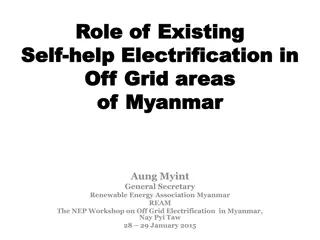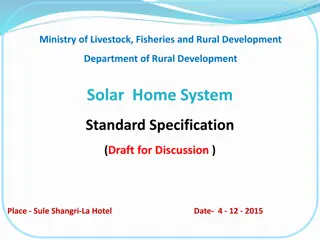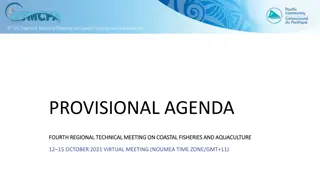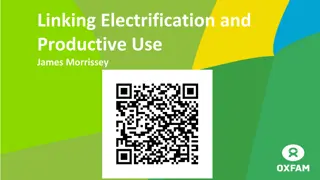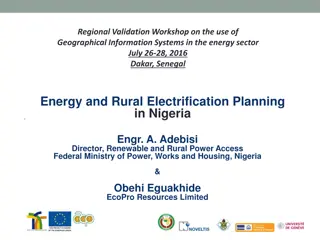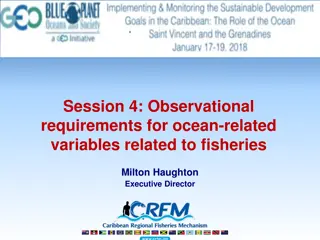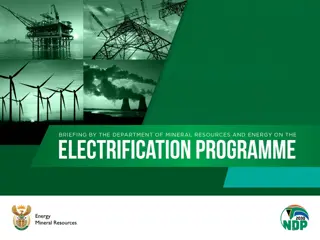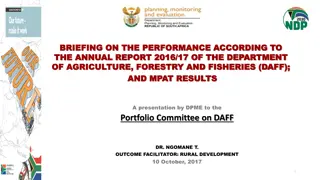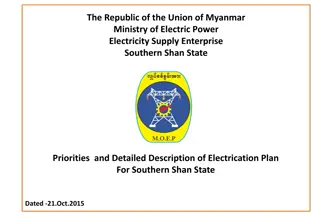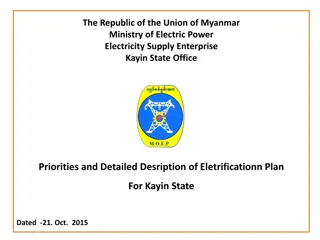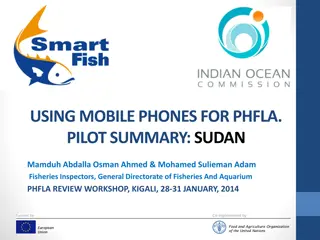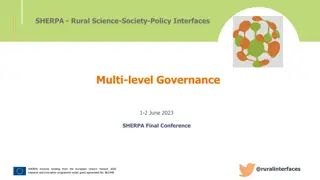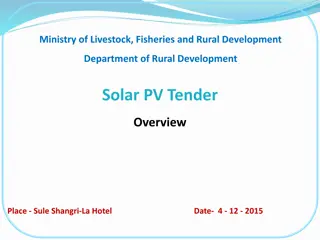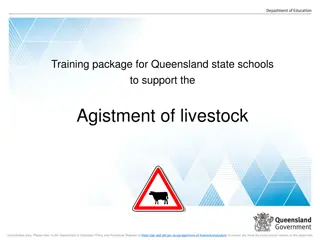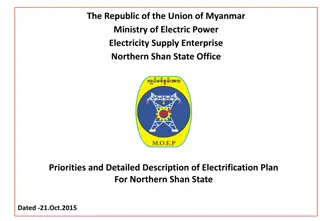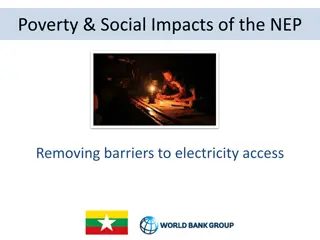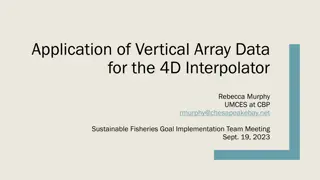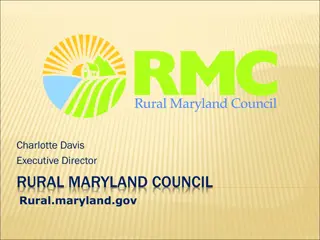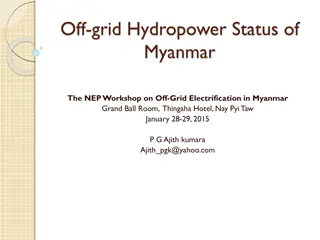Rural Electrification Initiatives by Ministry of Livestock, Fisheries, and Rural Development
Explore the comprehensive efforts of the Department of Rural Development under the Ministry of Livestock, Fisheries, and Rural Development towards rural electrification in Myanmar. The presentation covers the national electrification plan, implementation progress, vision for rural development, relevant ministries involved, and involvement of international development partners.
Uploaded on Oct 07, 2024 | 0 Views
Download Presentation

Please find below an Image/Link to download the presentation.
The content on the website is provided AS IS for your information and personal use only. It may not be sold, licensed, or shared on other websites without obtaining consent from the author. Download presentation by click this link. If you encounter any issues during the download, it is possible that the publisher has removed the file from their server.
E N D
Presentation Transcript
Rural Electrification Access by Department of Rural Development Ministry of Livestock, Fisheries and Rural Development 30. 7. 2015 1
Outline of Presentation Overview of Off-grid rural electrification by DRD National Electrification Plan (Off-grid) 2
Ministry of Livestock, Fisheries and Rural Development Vision: In Line with MDG, to develop rural area, to improve socioeconomic life of rural populace and to narrow down the development gap between urban and rural areas. Relevant Ministries on Myanmar Rural Electrification Ministry of Energy Ministry of Electrical Power Ministry of Industry Ministry of Science and Technology Ministry of Agriculture and Irrigation Ministry of Livestock, Fisheries and Rural Development 3
70000 63899 Implementation for Rural Electrification 60000 50000 41164 40000 30000 19791 20000 10000 2944 0 Total Villages Implemented Villages Until 2014-2015 Implementing Villages 2015-2016 Remaining Villages 4
System of Rural Electrified Villages in the Entire Country Grid line 1.64% Diesel Generator 35% Mini-hydro Solar 33.24% 25% Solar Mini-grid 5% Wind Bio-mass, Bio-gas Systems of Rural Electrified Villages in the Entire Country Grid Line Diesel Generator Mini-hydro Solar Solar Mini-grid Wind Bio-mass, Bio-gas 35% 25% 5% 33.24% 0.11% 0.01% 1.64% 5
Implementations of Rural Electrification from 2012-2013 to 2015-2016 ( By Department of Rural Development ) Total Electrification Systems Budget Effective Effective Sr. FY Years Hydro- Power Diesel Engine Villages Electric Solar Biogas (Million) Household Population 1 2012-2013 184 - 184 - - - 2955.4 17616 93386 2 2013-2014 205 4 148 51 2 - 4328.3216 39670 185652 3 2014-2015 1689 84 1595 131 8 2 40599.974 207465 1034344 4 2015-2016 2308 223 139863 34 1 - 36298.623 146123 749098 Total 4386 311 141790 216 11 2 84182.3186 410874 2062480 6
International Development Partners Brief Description of the project, activities Project Name & Implementer/Owner IDA (loan) Grant Implementation Period JICS Pilot Project 994 millions (JPY) 2014-2017 ICDF Pilot Project 350,000 (USD) 2014-2015 ADB CDTA 2 millions (USD) 2014-2016 ESCAP Pilot Project 322,050 (USD) 2013-2015 KFW Pilot Project 9 millions (EURO) 2015-2016 0.279 millions (USD) JICA Pilot Project 2014-2016 National 90 millions (USD) WB 2016-2021 Electrification Plan 7
National Electrification Plan: Phase 1- (2016 2030) Objective: To achieve universal access to electricity in Myanmar by 2030 Leading Ministries MOEP MLFRD Off-grid Grid Extension
Leastcost recommendation for 2030 By 2030, the majority are grid connections This represents 7.2 million households Total cost is estimated at US $5.8 billion (US$800 per connection, average) 9
NEP - Phase 1 (2016-2021) IDA credit of $400 million by World Bank finance. Four Components Component 1: grid extension (IDA $300 million) Component 2: off-grid electrification (IDA $80 million); Component 3: technical assistance and project management (IDA $20 million), and Component 4: contingent emergency response (IDA $0).
Financial Allocation by IDA for Off- grid Electrification (Phase-1, 2016-2021) Mini- grid Total (USD) Million Public Institution Technical Assistance SHS WB s IDA contribution (USD) Million 7 53 20 10 90
Component 2: Off-Grid Electrification (IDA $ 80Million) To target the communities unlikely to receive grid-based access ever or within the next 10 years. Technology neutral approach; MFLRD (DRD) to lead needs assessment at community level. Technology options include: solar photovoltaic (PV); mini- hydropower; wind; diesel; hybrid (e.g. diesel/solar). IDA finance will support: 1. Solar photovoltaic devices or systems for a target of 465,500 households 2. Mini-grids to serve some 35,500 households 3. Electricity connections for 11,400 health clinics, schools and other community buildings and 19,000 public street lights
Component 2: Off- grid Mini-grid: (IDA$ 7million) Micro-hydropower Other mini-grid technologies such as biomass, biogas, solar and wind. Up to 1MW in capacity are eligible Solar Home System: (IDA$ 53million) Solar panel peak wattage (Wp) 20 40 60 80 6-7 LED lights, cell phone, TV, fan 3 LED lights, cell phone 4 5 LED lights, cell phone, TV 5-6 LED lights, cell phone, TV Design Estimated cost for quality system (USD) 230 300 350 400
Public institutions potion: (IDA$ 20million) Connection Type System quantity Cost per system Equipment Cost Total 30,400 N/A $20million Schools 3,800 $1,000 $3.8million Religious building 3,800 $1,000 $3.8million Health clinics 3,800 $2,000 $7.6million Public (street) lights 19,000 $250 $4.75million Public institutions potion target Schools, Clinics, Religious buildings and Street lighting Each affected village is assumed to have one school, one clinic, one religious building and five street lights.
Component 3: Technical Assistance, Off-grid (IDA$10Million) Capacity building and training of the Project Management Offices. (Union, State/Region, district, township and village level, private sector) Improve the policy and regulatory framework. Standards, technology assessments and technical design, economics and financial analysis, environmental and social impact management, procurement and financial management, Strengthening project management
Financial Contribution for sub-components of Component 2 DRD HH WB s IDA contribution (USD) Million Total (USD) Million contribution (USD) Million contribution (USD) Million System Mini-grid 7 7 11 25 SHS 53 53 20 126 Public Institution - 20 - 20 Total 60 80 31 171
SHS - Under the National Electrification Plan s National Geospatial, Least-Cost Electrification Plan.; and - Only households that did not receive SHS previously under DRD s earlier SHS programs are eligible. - focuses on best available, price-competitive technologies from pico-photovoltaic units and solar kits up to large solar home systems of 100 watts peak (Wp). Indicative portion of system cost covered by grant, customer contribution, and financing during Phase I. Year 1 Year 2 Year 3 Year 4 Year 5 85 % Portion of cost covered by project funds 90 % 87 % 82% 80% Portion covered by customer contribution 10 % 13 % 15 % 18 % 20 %
Mini-grid - Micro-hydropower , biomass, biogas, solar and wind. - Hybrid systems that include a backup diesel generator are also eligible. - Mini-grids up to 1 MW in capacityare eligible for support under the program. Site conditions - Clustered housing - Nearby stream of sufficient water flow and head in case of mini-hydropower - - Opportunities for productive-use loads Indicative portion of system cost covered by grant, customer and mini-grid business contribution, and financing during Phase I. Year 1 Year 2 Year 3 Year 4 Year 5 Portion of cost covered by project funds 80% 80% 60% 50% 50% Portion covered by customer contribution 20% 20% 40% 50% 50%
Public institutions 100% grant-funded systems for schools, religious buildings, and health clinics , street lightings in target villages where households solutions are provided Connection Type System Quantity Schools 3800 Religious Buildings 3800 Health Clinics 3800 Street Lightings 19,000 Total 30,400
Organization Structures National Electrification Executive Committee (NEEC) NEP( PMO) MOEP (PMO) MLFRD (PMO)
ANNOUNCINGTHEPROGRAMTO TARGETVILLAGES In coordination with Union level (PMO) DRD office and Local government The district or township level DRD office informs the villagers at Local Township Development Committee meeting. DRD is ready to initiate a local program to make available SHS, mini-grids, or both SHS and mini-grids in the area. To inform the public of the process by which SHS and /or mini-grid will be deployed, household contribution and subsidy through media.
PROCEDURESFOR SHS Site, villages and projects selection Prioritizing villages Community organization and mobilization Opportunity to pursue a Mini-grid Household-by-household solar home system size selection process Customer SHS selection and collection of down payment VEC / DRD down payment receipt and village total number of systems of each type Public Facilities and Costing Technical Standards for SHS products Tendering and procurement Supply and installation, user training and supervision Compliance verification of installations O&M and spares services Monitoring of company performance
PROCEDURESFOR Mini-grids From pilot mini-grids to full implementation Village criteria for mini-grid eligibility Mini- grid size limits Mini-grid screening process Projects identified by developers Projects identified by DRD Technical Standards for Mini-grids Commissioning and training O&M and spares services
Mini-grid Screening Process Projects identified by developers Projects identified by DRD Project proposals List of Mini- grid project proposals Input from VECs Input from VECs Not viable Viable Screening by PMO (union level) SHS Needs further investigation Pre-feasibility study Feasibility study Not viable PMO evaluation Viable Mini-grid construction & commissioning
MONITORING & REPORTING Report indicators every six months put into their system. Reports every 6 months need to send financial management report. Combination of record keeping, report generating, field visits and discussion meetings.
Budget Allocation for NEP, Off-grid Electrification Fiscal Year (2016-2017) System DRD budget USD World Bank (IDA) USD Community USD (Million) Total Estimated (HHs) Remark 36 18 60 6 million million million million 58 SHS - - - 165714 350USD/HH million 2 Mini-grid - - - 2500 800USD/HH million 2 Technical Assistance - 2 - million million
Project Benefits Access to electricity (estimated 6 million people by 2021). Reduced cost of electricity supply. Enhanced well being through electricity for lighting in houses and streets, telecommunications and entertainment. Enhanced income generation opportunities and potential productivity improvements. Prioritization of connections for health clinics, schools, religious buildings and community centers. Strengthened institutional capacity of implementing agencies, including public and private sector agencies and organizations active in the grid and off-grid components. Improved participation of community members in decision-making processes for rural electrification. Strengthened capacity of Village Electrification Committees (VECs).



